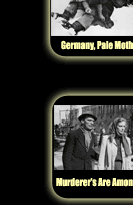

Germany, Pale Mother
(Deutschland, bleiche Mutter)The film begins in the 1930s as the young Lene decides to marry Hans, the decision greatly due to the fact that he is not a member of the Nazi party. However, he is soon drafted and sent to the front. After spending so much time in the military, witnessing and participating in brutal atrocities, Hans becomes bitter and coarse. Lene has his child, Anna, while she is alone during the war years, and they undertake a journey across the land. When Hans returns from a POW camp after the war, he has become alienated from the two women, and the family is unable to be happy together. Lene begins drinking and acquires facial paralysis. She starts to reject even her daughter's love, and finally attempts to commit suicide.
It is obvious that Hans is affected by his war experiences, since he returns and is self-absorbed and hardened by the atrocities. However, the film deals primarily with the traumatic postwar experiences of women and children. Similar to many women during World War II, Lene was forced to become a leader and a strong person while her husband was away. However, when he returns, she is again trapped in the domestic scene. She is alienated from her husband, and feels alone and worthless. Lene continuously deteriorates until she reaches the point of attempted suicide. Anna does not know her father, and it is difficult for her to accept him when he finally returns from the war. Also, her mother begins to reject her, forcing her to grow up quickly and virtually alone. This scars the child for life. Thus, for many Germans, it was not possible for them to cope with the past, and it not only affected the war generation, but also the following generation.


